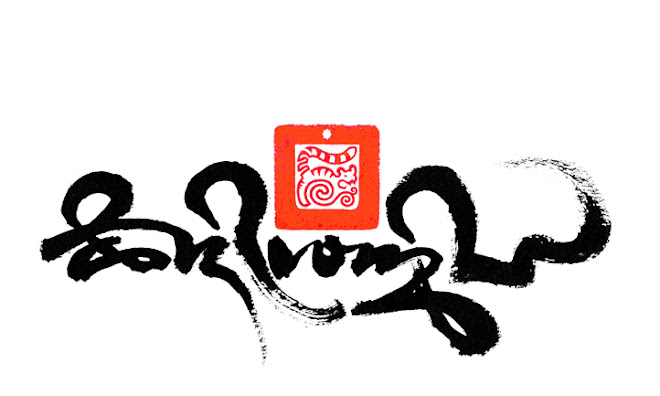 |
| A seal design for the Stupa project of Samye Ling. As all Stupas, the very top above the 12 levels to enlightenment is the Sun and moon emblem. |
The sun and the moon is perhaps one of the oldest of depicted images for all cultures around the world, indeed the use of symbols are known in the ancient world such as the Swastika, this in India is known as the sign for the sun and good luck.
Of course there is a wealth of meaning associated with sun and moon, however in this page i focus on the meaning of sun and moon and its symbolic use in Eastern Scripts and iconography.
The powerful Kalachakra monogram, a combination character of the seven intertwined letters of the Kalachakra mantra: Ham Ksha Ma La Wa Ra Ya. The sun and moon crowns the emblem, either side are the Eh and Wam wartu Sanskrit letters. These are all seated on a lotus and moon seat, representing transformation and purity. image from Tashi Lhunpo monastery in Tibet.
Of the many forms of the Om character, from the Siddham script to Tibetan, Perhaps the most familiar is the Om Character in the Devanagari Sanskrit script as above.
As with the Tibetan Om, the sun and moon is not just decorative but has a part to play in the pronunciation of the character, this is known as the 'mo' sound, which changes the 'Aa' into 'Om' sound.
for more examples of the Om Character in other scripts, Yoso has a very informative blog you may like to follow.
 |
| Here shows the Tibetan Hum character with the sun and moon 'Ma' sound at the top. © Tashi Mannox 2007. |

A detail of another painting by Tashi, part of his "laughing in the face of death" collection 2008. shows the sun and moon at the top of the scull in gold and silver leaf, © Tashi Mannox.
The Sun and moon in this context is symbolic of Wisdom and compassion, the emblem of balance and harmony.

The meaning of the sun and moon seems to differ from East to Western cultures. In the West we tend to associate the sun being the masculine fire element, the moon being the female water element. Whereas in Eastern philosophy, it is quite the opposite: The sun being the female because of the association with the red nurturing element, the moon being male because of the association with the white seed (Tigli) essence of life element.
 |
| The words for moon and sun shown here in the Tibetan drucha script which are arranged as roundels. silver and gold leaf on paper, art work 2004 © Tashi Mannox. |



The Moon and Sun, treated with silver and gold leaf. Are probably my favourite piece :)
ReplyDeleteKeep growing strong! Keep shining!
Yoso
Dear Tashi--
ReplyDeleteI am looking to get my first tattoo and want it to be both beautiful and meaningful. I would also consider getting my name in uchen or drucha because my name is Melody and I am curious if there is a translation for that. I hope to hear from you soon. Thank you n much love,
Melody